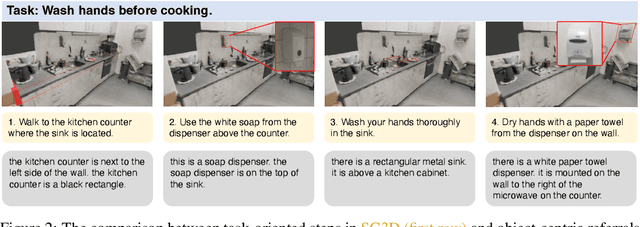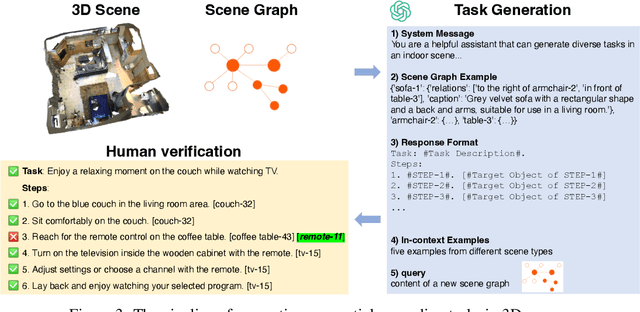Baoxiong Jia
Unveiling the Mist over 3D Vision-Language Understanding: Object-centric Evaluation with Chain-of-Analysis
Apr 01, 2025Abstract:Existing 3D vision-language (3D-VL) benchmarks fall short in evaluating 3D-VL models, creating a "mist" that obscures rigorous insights into model capabilities and 3D-VL tasks. This mist persists due to three key limitations. First, flawed test data, like ambiguous referential text in the grounding task, can yield incorrect and unreliable test results. Second, oversimplified metrics such as simply averaging accuracy per question answering (QA) pair, cannot reveal true model capability due to their vulnerability to language variations. Third, existing benchmarks isolate the grounding and QA tasks, disregarding the underlying coherence that QA should be based on solid grounding capabilities. To unveil the "mist", we propose Beacon3D, a benchmark for 3D-VL grounding and QA tasks, delivering a perspective shift in the evaluation of 3D-VL understanding. Beacon3D features (i) high-quality test data with precise and natural language, (ii) object-centric evaluation with multiple tests per object to ensure robustness, and (iii) a novel chain-of-analysis paradigm to address language robustness and model performance coherence across grounding and QA. Our evaluation of state-of-the-art 3D-VL models on Beacon3D reveals that (i) object-centric evaluation elicits true model performance and particularly weak generalization in QA; (ii) grounding-QA coherence remains fragile in current 3D-VL models, and (iii) incorporating large language models (LLMs) to 3D-VL models, though as a prevalent practice, hinders grounding capabilities and has yet to elevate QA capabilities. We hope Beacon3D and our comprehensive analysis could benefit the 3D-VL community towards faithful developments.
Building Interactable Replicas of Complex Articulated Objects via Gaussian Splatting
Feb 26, 2025Abstract:Building articulated objects is a key challenge in computer vision. Existing methods often fail to effectively integrate information across different object states, limiting the accuracy of part-mesh reconstruction and part dynamics modeling, particularly for complex multi-part articulated objects. We introduce ArtGS, a novel approach that leverages 3D Gaussians as a flexible and efficient representation to address these issues. Our method incorporates canonical Gaussians with coarse-to-fine initialization and updates for aligning articulated part information across different object states, and employs a skinning-inspired part dynamics modeling module to improve both part-mesh reconstruction and articulation learning. Extensive experiments on both synthetic and real-world datasets, including a new benchmark for complex multi-part objects, demonstrate that ArtGS achieves state-of-the-art performance in joint parameter estimation and part mesh reconstruction. Our approach significantly improves reconstruction quality and efficiency, especially for multi-part articulated objects. Additionally, we provide comprehensive analyses of our design choices, validating the effectiveness of each component to highlight potential areas for future improvement.
MOVIS: Enhancing Multi-Object Novel View Synthesis for Indoor Scenes
Dec 16, 2024



Abstract:Repurposing pre-trained diffusion models has been proven to be effective for NVS. However, these methods are mostly limited to a single object; directly applying such methods to compositional multi-object scenarios yields inferior results, especially incorrect object placement and inconsistent shape and appearance under novel views. How to enhance and systematically evaluate the cross-view consistency of such models remains under-explored. To address this issue, we propose MOVIS to enhance the structural awareness of the view-conditioned diffusion model for multi-object NVS in terms of model inputs, auxiliary tasks, and training strategy. First, we inject structure-aware features, including depth and object mask, into the denoising U-Net to enhance the model's comprehension of object instances and their spatial relationships. Second, we introduce an auxiliary task requiring the model to simultaneously predict novel view object masks, further improving the model's capability in differentiating and placing objects. Finally, we conduct an in-depth analysis of the diffusion sampling process and carefully devise a structure-guided timestep sampling scheduler during training, which balances the learning of global object placement and fine-grained detail recovery. To systematically evaluate the plausibility of synthesized images, we propose to assess cross-view consistency and novel view object placement alongside existing image-level NVS metrics. Extensive experiments on challenging synthetic and realistic datasets demonstrate that our method exhibits strong generalization capabilities and produces consistent novel view synthesis, highlighting its potential to guide future 3D-aware multi-object NVS tasks.
Multi-modal Situated Reasoning in 3D Scenes
Sep 04, 2024



Abstract:Situation awareness is essential for understanding and reasoning about 3D scenes in embodied AI agents. However, existing datasets and benchmarks for situated understanding are limited in data modality, diversity, scale, and task scope. To address these limitations, we propose Multi-modal Situated Question Answering (MSQA), a large-scale multi-modal situated reasoning dataset, scalably collected leveraging 3D scene graphs and vision-language models (VLMs) across a diverse range of real-world 3D scenes. MSQA includes 251K situated question-answering pairs across 9 distinct question categories, covering complex scenarios within 3D scenes. We introduce a novel interleaved multi-modal input setting in our benchmark to provide text, image, and point cloud for situation and question description, resolving ambiguity in previous single-modality convention (e.g., text). Additionally, we devise the Multi-modal Situated Next-step Navigation (MSNN) benchmark to evaluate models' situated reasoning for navigation. Comprehensive evaluations on MSQA and MSNN highlight the limitations of existing vision-language models and underscore the importance of handling multi-modal interleaved inputs and situation modeling. Experiments on data scaling and cross-domain transfer further demonstrate the efficacy of leveraging MSQA as a pre-training dataset for developing more powerful situated reasoning models.
PhysPart: Physically Plausible Part Completion for Interactable Objects
Aug 25, 2024



Abstract:Interactable objects are ubiquitous in our daily lives. Recent advances in 3D generative models make it possible to automate the modeling of these objects, benefiting a range of applications from 3D printing to the creation of robot simulation environments. However, while significant progress has been made in modeling 3D shapes and appearances, modeling object physics, particularly for interactable objects, remains challenging due to the physical constraints imposed by inter-part motions. In this paper, we tackle the problem of physically plausible part completion for interactable objects, aiming to generate 3D parts that not only fit precisely into the object but also allow smooth part motions. To this end, we propose a diffusion-based part generation model that utilizes geometric conditioning through classifier-free guidance and formulates physical constraints as a set of stability and mobility losses to guide the sampling process. Additionally, we demonstrate the generation of dependent parts, paving the way toward sequential part generation for objects with complex part-whole hierarchies. Experimentally, we introduce a new metric for measuring physical plausibility based on motion success rates. Our model outperforms existing baselines over shape and physical metrics, especially those that do not adequately model physical constraints. We also demonstrate our applications in 3D printing, robot manipulation, and sequential part generation, showing our strength in realistic tasks with the demand for high physical plausibility.
SlotLifter: Slot-guided Feature Lifting for Learning Object-centric Radiance Fields
Aug 13, 2024Abstract:The ability to distill object-centric abstractions from intricate visual scenes underpins human-level generalization. Despite the significant progress in object-centric learning methods, learning object-centric representations in the 3D physical world remains a crucial challenge. In this work, we propose SlotLifter, a novel object-centric radiance model addressing scene reconstruction and decomposition jointly via slot-guided feature lifting. Such a design unites object-centric learning representations and image-based rendering methods, offering state-of-the-art performance in scene decomposition and novel-view synthesis on four challenging synthetic and four complex real-world datasets, outperforming existing 3D object-centric learning methods by a large margin. Through extensive ablative studies, we showcase the efficacy of designs in SlotLifter, revealing key insights for potential future directions.
Task-oriented Sequential Grounding in 3D Scenes
Aug 07, 2024



Abstract:Grounding natural language in physical 3D environments is essential for the advancement of embodied artificial intelligence. Current datasets and models for 3D visual grounding predominantly focus on identifying and localizing objects from static, object-centric descriptions. These approaches do not adequately address the dynamic and sequential nature of task-oriented grounding necessary for practical applications. In this work, we propose a new task: Task-oriented Sequential Grounding in 3D scenes, wherein an agent must follow detailed step-by-step instructions to complete daily activities by locating a sequence of target objects in indoor scenes. To facilitate this task, we introduce SG3D, a large-scale dataset containing 22,346 tasks with 112,236 steps across 4,895 real-world 3D scenes. The dataset is constructed using a combination of RGB-D scans from various 3D scene datasets and an automated task generation pipeline, followed by human verification for quality assurance. We adapted three state-of-the-art 3D visual grounding models to the sequential grounding task and evaluated their performance on SG3D. Our results reveal that while these models perform well on traditional benchmarks, they face significant challenges with task-oriented sequential grounding, underscoring the need for further research in this area.
Unifying 3D Vision-Language Understanding via Promptable Queries
May 19, 2024



Abstract:A unified model for 3D vision-language (3D-VL) understanding is expected to take various scene representations and perform a wide range of tasks in a 3D scene. However, a considerable gap exists between existing methods and such a unified model, due to the independent application of representation and insufficient exploration of 3D multi-task training. In this paper, we introduce PQ3D, a unified model capable of using Promptable Queries to tackle a wide range of 3D-VL tasks, from low-level instance segmentation to high-level reasoning and planning. This is achieved through three key innovations: (1) unifying various 3D scene representations (i.e., voxels, point clouds, multi-view images) into a shared 3D coordinate space by segment-level grouping, (2) an attention-based query decoder for task-specific information retrieval guided by prompts, and (3) universal output heads for different tasks to support multi-task training. Tested across ten diverse 3D-VL datasets, PQ3D demonstrates impressive performance on these tasks, setting new records on most benchmarks. Particularly, PQ3D improves the state-of-the-art on ScanNet200 by 1.8% (AP), ScanRefer by 5.4% (acc@0.5), Multi3DRefer by 11.7% (F1@0.5), and Scan2Cap by 13.4% (CIDEr@0.5). Moreover, PQ3D supports flexible inference with individual or combined forms of available 3D representations, e.g., solely voxel input.
Closed-Loop Open-Vocabulary Mobile Manipulation with GPT-4V
Apr 16, 2024



Abstract:Autonomous robot navigation and manipulation in open environments require reasoning and replanning with closed-loop feedback. We present COME-robot, the first closed-loop framework utilizing the GPT-4V vision-language foundation model for open-ended reasoning and adaptive planning in real-world scenarios. We meticulously construct a library of action primitives for robot exploration, navigation, and manipulation, serving as callable execution modules for GPT-4V in task planning. On top of these modules, GPT-4V serves as the brain that can accomplish multimodal reasoning, generate action policy with code, verify the task progress, and provide feedback for replanning. Such design enables COME-robot to (i) actively perceive the environments, (ii) perform situated reasoning, and (iii) recover from failures. Through comprehensive experiments involving 8 challenging real-world tabletop and manipulation tasks, COME-robot demonstrates a significant improvement in task success rate (~25%) compared to state-of-the-art baseline methods. We further conduct comprehensive analyses to elucidate how COME-robot's design facilitates failure recovery, free-form instruction following, and long-horizon task planning.
PhyScene: Physically Interactable 3D Scene Synthesis for Embodied AI
Apr 15, 2024Abstract:With recent developments in Embodied Artificial Intelligence (EAI) research, there has been a growing demand for high-quality, large-scale interactive scene generation. While prior methods in scene synthesis have prioritized the naturalness and realism of the generated scenes, the physical plausibility and interactivity of scenes have been largely left unexplored. To address this disparity, we introduce PhyScene, a novel method dedicated to generating interactive 3D scenes characterized by realistic layouts, articulated objects, and rich physical interactivity tailored for embodied agents. Based on a conditional diffusion model for capturing scene layouts, we devise novel physics- and interactivity-based guidance mechanisms that integrate constraints from object collision, room layout, and object reachability. Through extensive experiments, we demonstrate that PhyScene effectively leverages these guidance functions for physically interactable scene synthesis, outperforming existing state-of-the-art scene synthesis methods by a large margin. Our findings suggest that the scenes generated by PhyScene hold considerable potential for facilitating diverse skill acquisition among agents within interactive environments, thereby catalyzing further advancements in embodied AI research. Project website: http://physcene.github.io.
 Add to Chrome
Add to Chrome Add to Firefox
Add to Firefox Add to Edge
Add to Edge